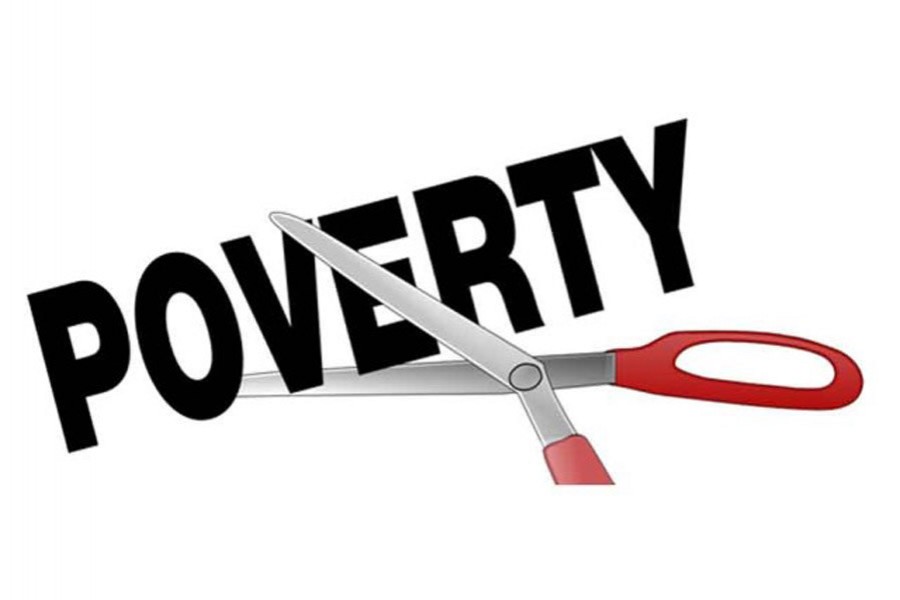Bangladesh has done pretty well in cutting income poverty. The Seventh Five Year Plan (2016-2020) - a document that reflects national hopes and aspirations at least for five years - in its preamble put poverty reduction as one of the perennial goals. Ipso facto, the plan aims to bring down overall incidence of poverty from about 25 per cent of 2015 to about 19 per cent in 2020, and extreme poverty from about 13 per cent to about 9.0 per cent during the same period. Despite cutting extreme poverty, however, from 34 per cent in 2000 to 13 per cent today - a laudable achievement, 20 million people still groan under extreme poverty - living on an amount of Tk 45 at the highest a day!
The role of the government in reducing poverty can hardly be overemphasized. NGOs have contributed with their microfinance programmes. But soon it was realised that the microcredit pogrammes tend to bypass a huge chunk of the ultra-poor, and from then on, targeting the ultra-poor became an avowed objective. Alongside government's efforts, a number of programmes/projects undertaken by different NGOs are also at work to address especially the extreme poor who are assetless, illiterate, and mostly day labourer consuming only 1,800 calories or less. The ultra-poor are a sub-set of the poor with less than 10 decimals of land, mostly women headed households with almost no male working member. Historically, this sub-set lived on philanthropic grants or at best serving as maids in other households.
In Bangladesh, there have been a few targeted livelihood programmes such as Economic Empowerment of the Poorest (EEP)/Shiree, Char Livelihood Programmes and Targeted Ultra-Poor Programme (TUP). By and large, there are Unconditional Cash transfer Programmes, Livelihood Programmes and Ultra-Poor Graduation Programme - mostly led by world famous NGO, BRAC. Available empirical evidences show that the existing programmes in Bangladesh helped effective reduction of extreme poverty. A well-defined marker of many of them has been to transfer assets (cow, goat) to them so that, after sometime, they can earn their own bread. Besides the transfer of assets, the recipients received training in asset management, savings and book keeping etc. that is 'non-tradable' and cannot be developed overnight.
The Copenhagen Consensus, in its concern over Bangladesh Development Priorities, carried out a cost-benefit analysis of different interventions for the poor. Done by the experts in this field, the studies argue that (a) a cash transfer of Tk 18,096 to a household generates Tk 80 out of a spending of Tk 100; (b) a livelihood intervention of Tk 7,800 to a household brings a benefit of Tk 100 out of a spending of Tk 100, and (c) the graduation programme, of Tk 23,400 per household, provides a benefit of Tk 200 out of a spending of Tk 1,000. In other words, the benefit-cost ratios of the interventions are 0.8, 1.0 and 2.0 respectively for (a), (b) and (c).
Why the graduation programme ranks the highest in terms of benefits generated for a given amount of cost? First, take the case of BRAC's TUP programme. It starts on the premise that: (a) the very poor needs a shield against day-to-day hunger; otherwise they might sell out the asset so received; (b) they must be trained about how to manage the asset and generate savings otherwise they would spoil the asset and (c) the recipient of assets must be supervised and monitored, lest the poor take a free ride and misuse the asset. Thus the 'package' comprises a consumption allowance to ensure food security in weeks without earning, a business/skill training and a transfer of asset.
The TUP model now operates in several countries in the world. A group of researchers led by Professor Abhijit Benarjee of the Michigan Institute of Technology (MIT) evaluated the programme using a Randomized Control Trial (RCT) and observed that the model has helped extreme poverty reduction in a sustainable manner in those countries. Inside Bangladesh, a number of studies observed that the model works well for the ultra-poor although experiments with alternative tools are at work. To be specific on this point, about ninety percent of the TUP members were found to be above the extreme poverty line even after 5 years when BRAC put its hands off from the assistance. The benefits came mostly from shifting occupation from day labour or maids to self-employment. The surveys also show that many of the women so far unheard or unsung were invited to join social programmes in the village-- be it marriage ceremony or other occasions.
The Bangladesh Government, in its efforts at eradicating extreme poverty has to seriously examine the cross-cuts among the existing interventions. Most importantly, cost-benefit analysis should pave ways and means to poverty reduction in a country with serious resource constraints. Secondly, the government could cooperate with NGOs (or the other way round) in the fulfilment of its objectives of drastically reducing extreme poverty. Knowing well that poverty cannot be contained by governments alone, the UN invited all stakeholders to assist the governments to see a state of "moving from humiliation and exclusion to participation: Ending poverty in all its forms".
However, only income poverty showed a significant decline but non-income poverty not as much as could be expected. It is because growth and development generate "spill-over bads" in terms of health, environment and other problems. So, it may happen that a substantial part of the incremental income is being spent on arresting the declining productivity rather than raising it. This means that cash transfers must take into account health expenses. Otherwise the poor will continue to remain poor even at a higher level of per capita income.
Abdul Bayes is a former Professor of Economics at Jahangirnagar University.


